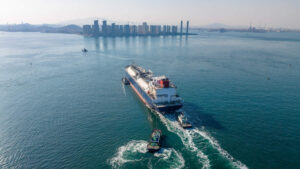ASX Green Energy Stocks: Alinta and Fortescue switch on WA’s largest remote solar farm

Pic: Matthias Kulka / The Image Bank via Getty Images
Western Australia’s largest solar farm has kicked off production for iron ore giant, Fortescue Metals Group (ASX:FMG).
The 60 MW Alinta Energy Chichester Hub Solar Farm in the Pilbara region – one of the sunniest regions in Australia – will power up to 100 per cent of daytime operations at Fortescue’s Christmas Creek and Cloudbreak sites, displacing around 100 million litres of diesel every year.
It features more than 160,000 solar panels and a PV panel area of 12Ha.
Supply will be backed up by battery storage and gas generation at Alinta Energy’s Newman Power Station.
Alinta managing director and CEO Jeff Dimery said the commencement of operations was a giant leap forward in the race towards a low-carbon energy future.
“We took an ambitious brief from Fortescue, who wanted to dramatically slash their emissions, and made it a reality in just three years.
“I can’t understate the engineering challenge of designing and building a renewable solution on this scale, in a harsh environment like the Pilbara, to meet the reliability standards of mines like these.”
In a statement this morning Fortescue said the completion of the project marks a major milestone in the delivery of Fortescue’s decarbonisation strategy, as the company works towards its ambitious target of being carbon neutral by 2030 for Scope 1 and 2 emissions.
“As Fortescue transitions from a pure play iron ore producer to a green energy and resources company, this milestone is a critical part of our Pilbara Energy Connect project which together with the Chichester solar farm will see 25 per cent of Fortescue’s stationary energy powered by solar,” CEO Elizabeth Gaines said.
Strike Energy’s Project Haber recognised as ‘strategically significant’
Strike Energy’s (ASX:STX) Project Haber has been recognised at both a State and Federal level after receiving a $2m grant under the Federal Government’s Supply Chain Resilience Initiative and gaining Lead Agency Status by the Western Australia Government.
The company intends to develop Project Haber into a 1.4mtpa urea fertiliser production facility near Geraldton in Western Australia’s Mid-West region, which it believes would replace Australia’s reliance on more than $1 billion of fertiliser imports each year.
In a market announcement today, Strike said Project Haber’s strategic significance in terms of generating a material domestic urea manufacturing capability has been validated.
“Project Haber’s location in the Mid-West is also set to be further supported by the West Australian Government’s announcement of ‘Hydrogen Hub’ status for the Mid-West,” the company said.
“This ‘Hub’ status could see public investment of around $117 million to be matched by Commonwealth funding pending the approval of the Clean Hydrogen Industrial Hubs grant.”
The mobilisation of equipment to the South Erregulla has begun with all permits received to start drilling.
It is targeting spud of SE-1 in late December with the Ensign 970 rig, which has come off the well-executed and successful Walyering-5 drilling campaign.
Urea market
As it stands, Strike said there is a global shortage of urea resulting from the ongoing northern hemisphere energy crisis.
The energy shortfall has resulted in significant quantities of urea manufacturing capacity being shut in, as gas feedstock have been diverted away from industry to primary use of power and heating.
Major urea exporting nations including Russia, Egypt and China, have subsequently placed restrictions on urea exports which has amplified the current supply shortage.
“This has translated into international urea pricing surpassing previous all-time record highs with FOB Middle East prices reaching more than US $1,000 per tonne in the spot market,” STX said.
However, Australia is currently on course to have zero domestic urea production capacity by December 2022, with Incitec Pivot Limited announcing the closure of its Gibson Island production facility.
Strike added: “Given Australia’s already high reliance on urea imports from the Middle East and China, this confluence of global and local events will leave Australian farmers fully exposed to international market conditions.”
A secondary impact is the availability – or more pertinently, non-availability – of AdBlue, a urea-based diesel engine exhaust fluid used for pollution (NOx) reduction in modern diesel and freight engines.
AdBlue (urea) shortages are forecast to start impacting international and Australian supply chains within the coming quarter, unless additional capacity is either built or supplies of urea improve.
STX said these macro-economic events highlights the vulnerability of parts of Australia’s economy to international energy markets and demonstrates the increasing importance of Project Haber to Australia’s agricultural and logistics industries.
UNLOCK INSIGHTS
Discover the untold stories of emerging ASX stocks.
Daily news and expert analysis, it's free to subscribe.
By proceeding, you confirm you understand that we handle personal information in accordance with our Privacy Policy.








